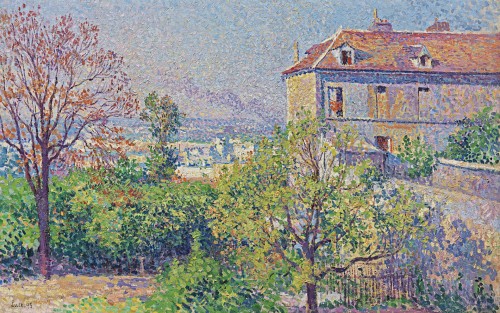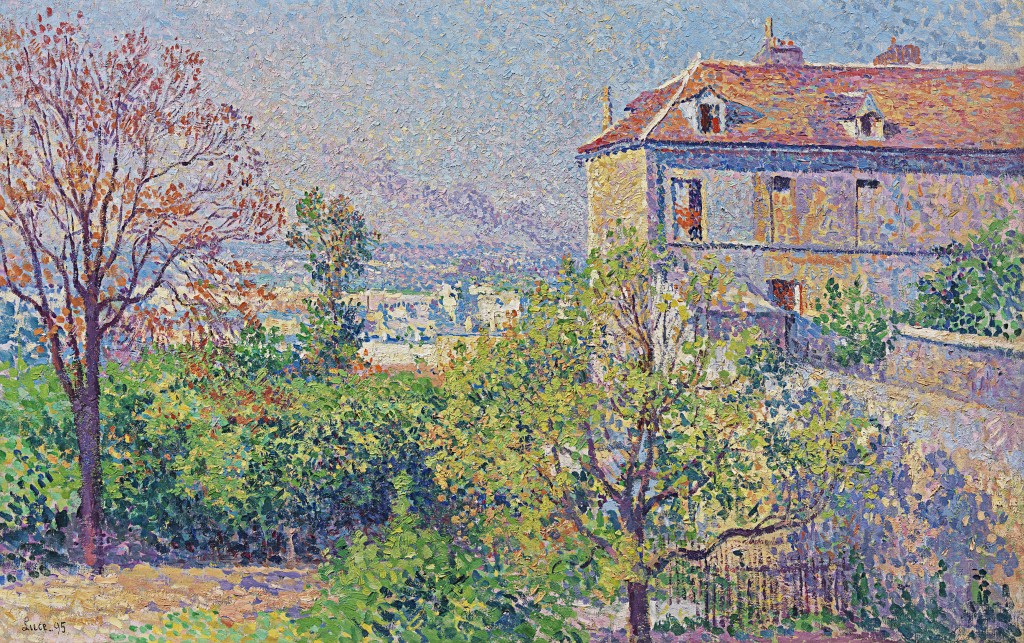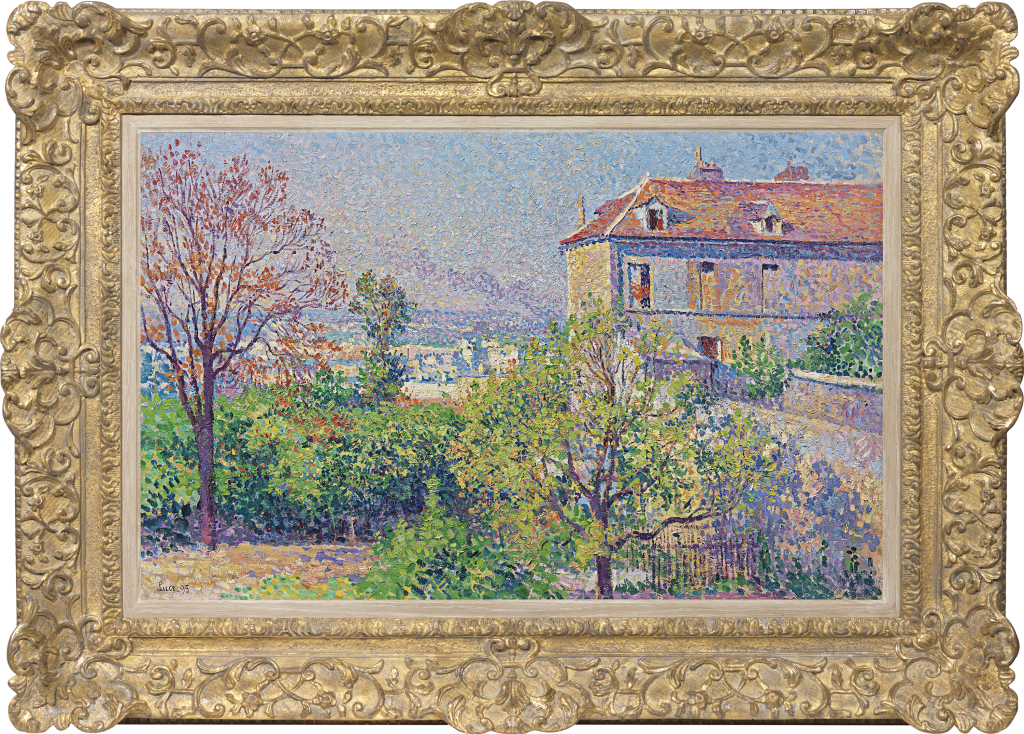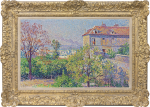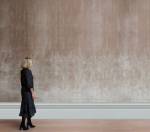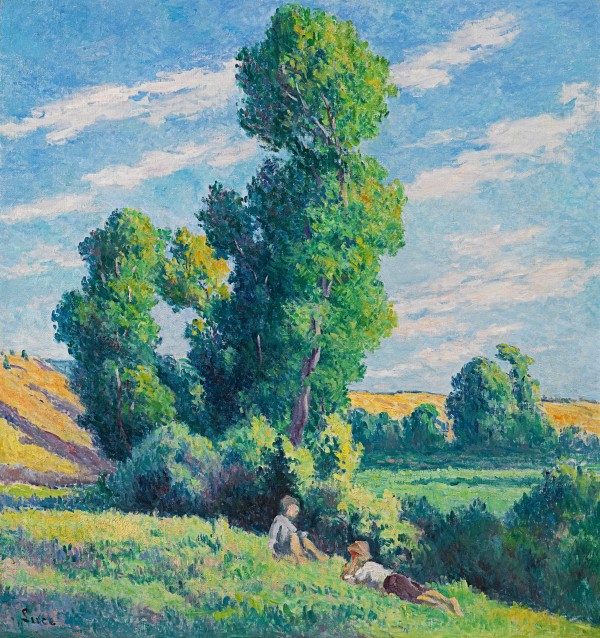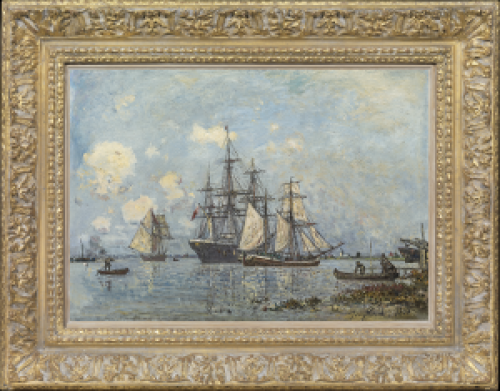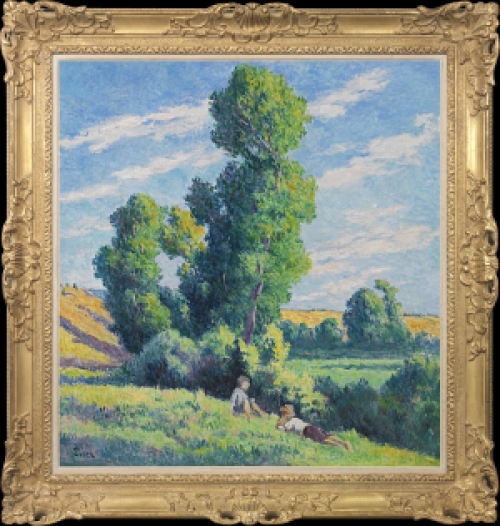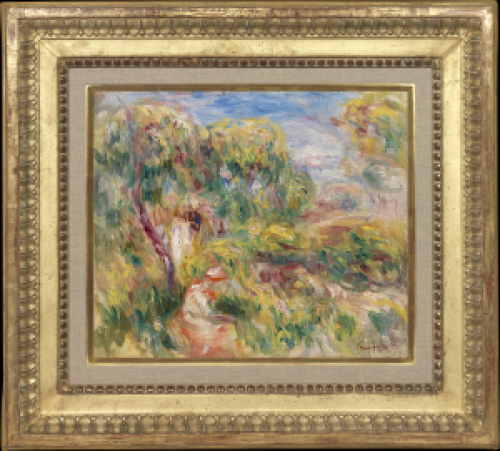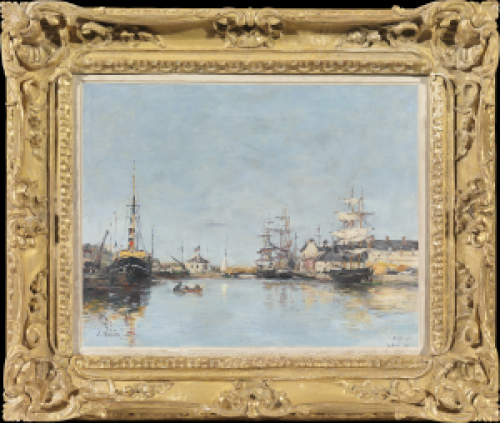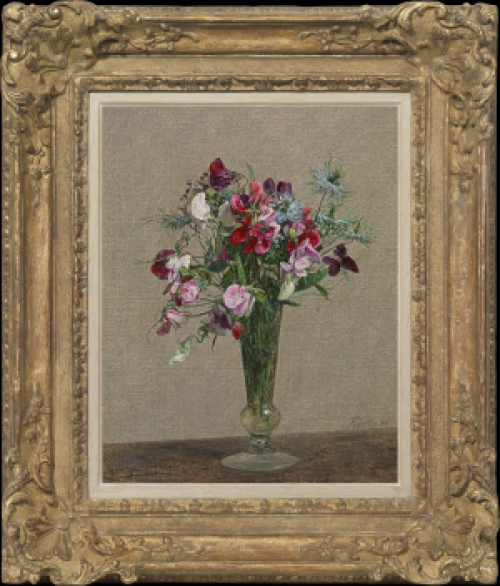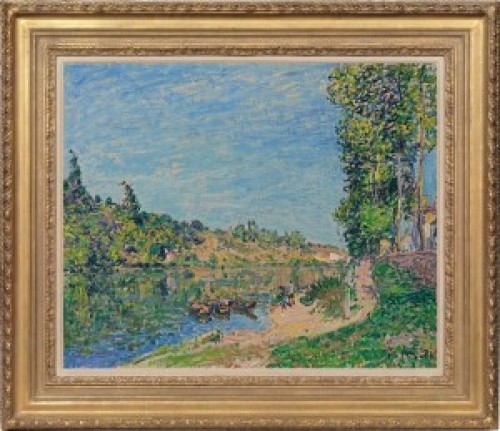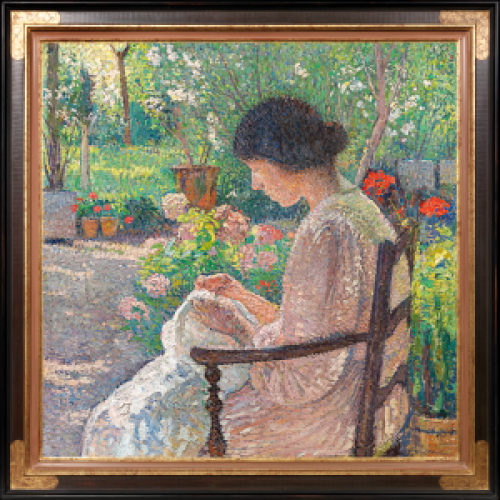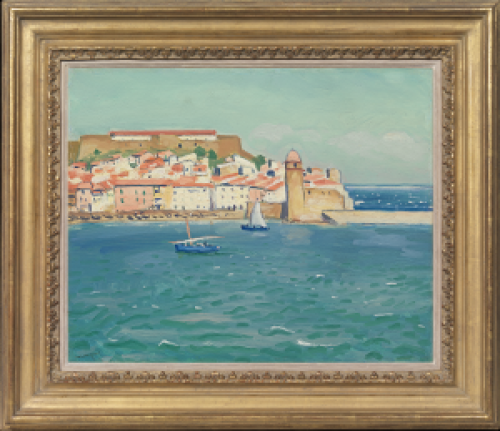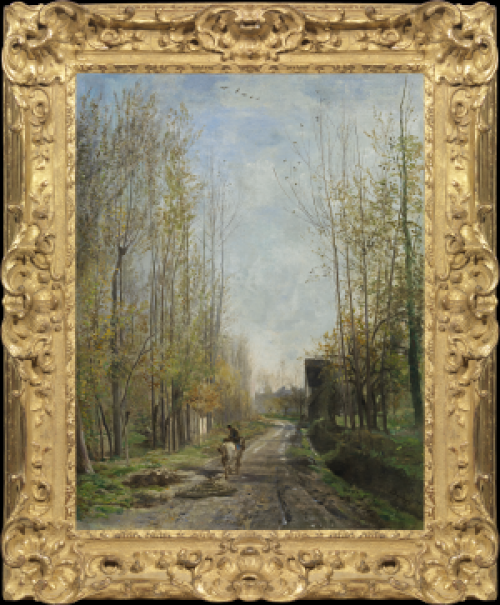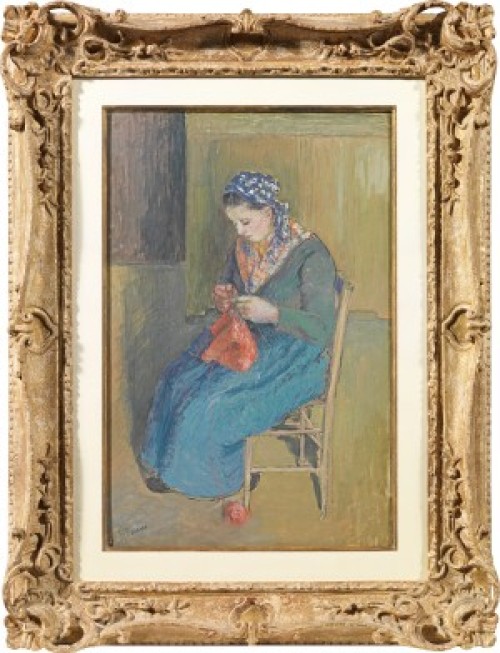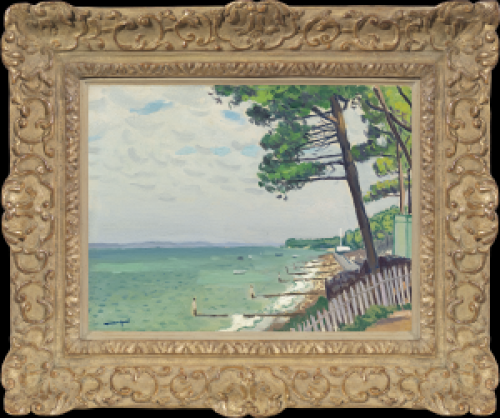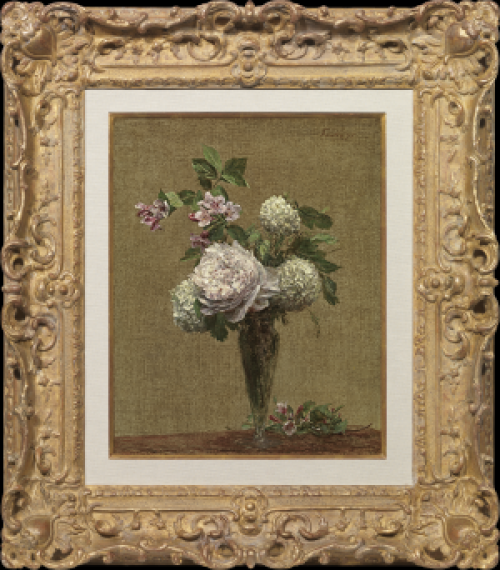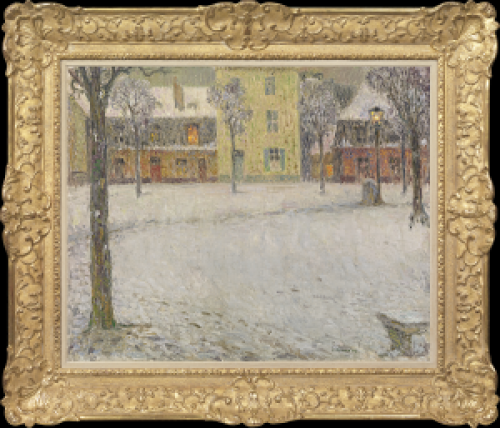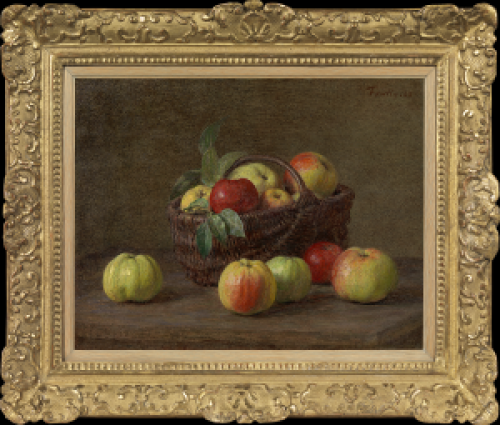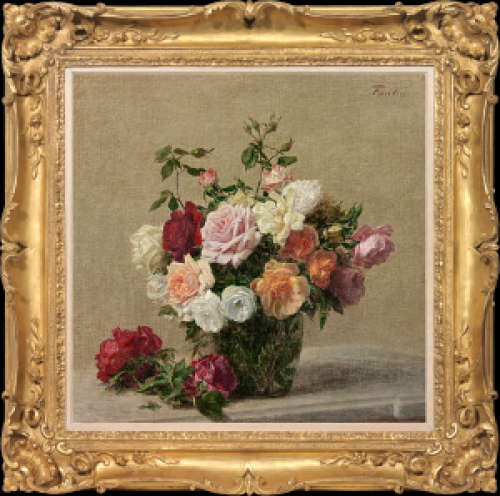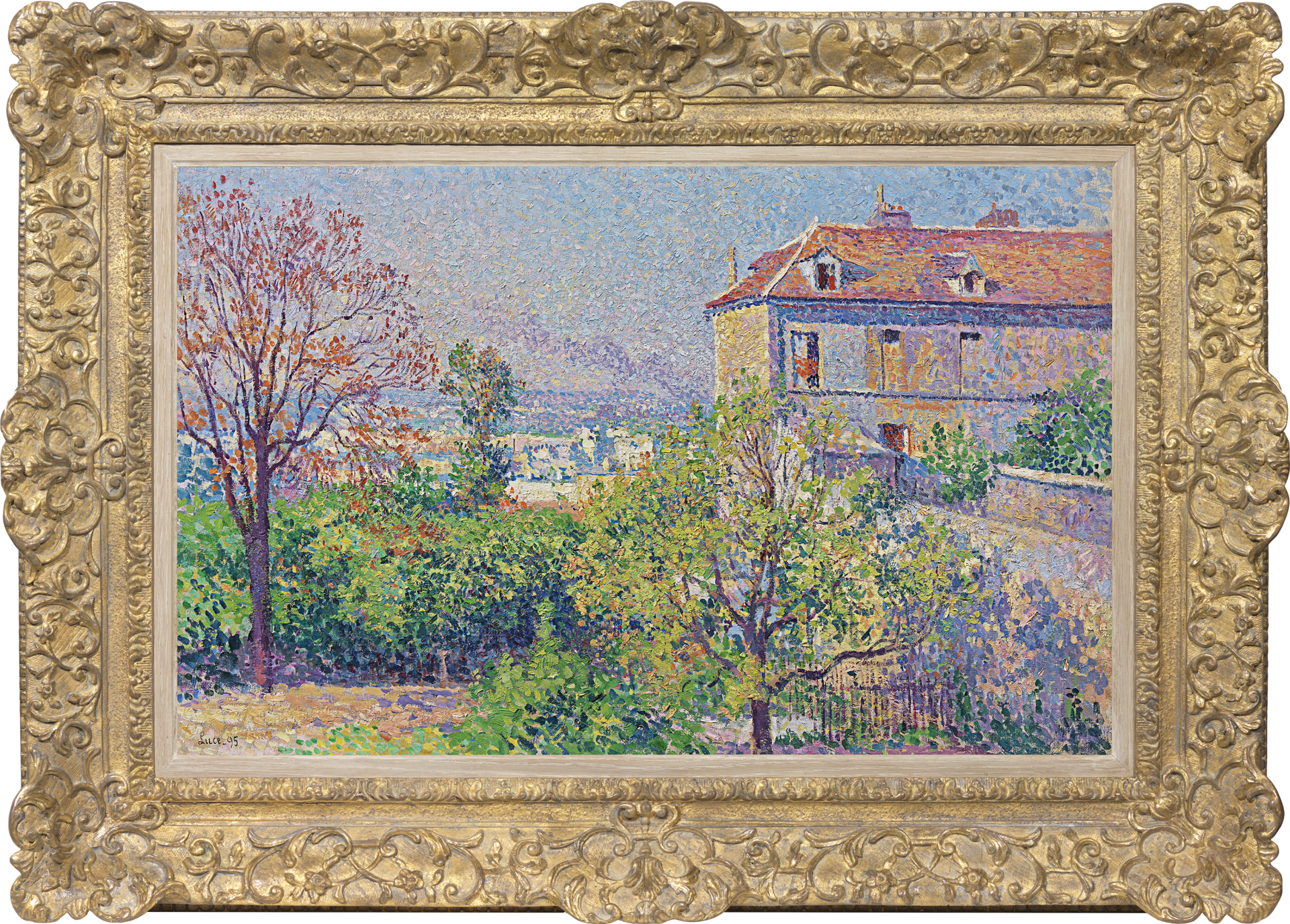MAXIMILIEN LUCE
1858 - Paris - 1941
Ref: CC 157
La maison de Suzanne Valadon
Signed and dated lower left: Luce. 95
Oil on canvas: 19 5/8 x 31 ¼ in / 49.8 x 79.4 cm
Frame size: 30 x 41 in / 76.2 x 104.1 cm
In a gilded Louis XIV style composition frame
Provenance:
Private collection, France;
from whom acquired in 1966 by Hammer Galleries, New York, inv. no.2007-1;
from which acquired by Fritz and Lucy Jewett, San Francisco, CA, December 1966
Literature:
Jean Bouin-Luce and Denise Bazetoux, Maximilien Luce, catalogue raisonné de l’oeuvre peint, Paris 1986, vol. II, p.50, no.174, illus.
Maximilien Luce was a child of Montmartre, born in 1858 in Rue Mayet, the son of a railway clerk and a sewing maid. As a child, he witnessed the Seige of Paris in the Franco-Prussian War and the brutal suppression of the left-wing Commune by the French Army which followed it in 1871. Luce retained a lifelong allegiance to this ramshackle northern district, the hardships and heroism of its petits gens and his Anarchist politics. This painting depicts the house of a future icon of Montmartre, the laundress-turned-trapeze artist-turned model-turned successful artist Suzanne Valadon (1865-1938).
Montmartre – Hill of the Martyr – was named in honour of Saint Denis, Patron Saint of Paris, who was said to have been beheaded there by the Romans. By the mid-nineteenth century the vineyards and mills which dotted its slopes were giving way to a warren of lanes and shanty buildings which housed the working poor. Low rents attracted artists from the 1870s. From the 1880s there were clustered increasing numbers of raffish cafés and cabarets on the hill: the Moulin Rouge, opened in 1889, took its inspiration from the working windmills of the past. Painters gathered at the Lapin Agile and the squalid Bateau Lavoir from the 1890s hosted the studio of Maxime Maufra and, later, that of Kees van Dongen, Picasso and many other members of the avant-garde. Today, suitably sanitised, Montmartre trades on the glorious heritage of the Vie de Bohème. The house in this painting is now part of the Musée de Montmartre, complete with a reconstruction of Valadon’s studio in an adjacent building.
Luce’s view of 1895 depicts the Maison Bel Air at 12 Rue Corot, a seventeenth century mansion that had seen better days and been divided into modest apartments. Renoir took a studio there in 1875, characteristically choosing to celebrate the wild abundance of the villa’s garden and the carefree life of its inhabitants in Garden in the rue Cortot, Montmartre, 1876 (Museum of Art, Carnegie Institute, Pittsburgh) and The swing, 1876 (Musée d’Orsay, Paris). Luce lived at 6 Rue Cortot from 1887-92 and 16 Rue Cortot 1892-99. Suzanne Valadon inhabited 12 Rue Cortot 1898-1905, for a year in 1909 and once more from 1911-25[1].
Luce’s painting captures the essence of a sun-warmed, fertile Bohemia rising above the grime of a rapidly-industrialising Paris. Its luminous joyousness is perhaps a reaction to one of the most traumatic events of his life. For six weeks in 1894 he had been imprisoned in Paris’s Mazas prison as a suspected agitator following the assassination of the French President Sadi Carnot by an Italian Anarchist.
The painting shows the influence of the Divisionist theories of his friends Georges Seurat (1859-1891) and Paul Signac (1863-1935), in which dabs of complementary or contrasting colour are placed unmixed on the canvas, melding in the eye to creature structure and harmony. This can be seen on the façade of the Maison Bel Air, where dabs of lilac, orange, blue, pink and primrose evoke the play of sunlight and shadow on the mellow stucco. However, Luce was never slavishly in thrall to Seurat’s scientific colour theories. He modulates his touch across the canvas, employing a freer, Neo-Impressionistic manner for the tree at the left and the foreground, while evoking the distant plains towards Saint Denis with tighter touches of pastel blue and pink. A plume of smoke drifts across the pulsating blue sky.
Luce makes full play of the still-bucolic aspects of Montmartre, the fecund garden of the Maison bursting with the tender green leaf of early spring, just as Renoir had done when he lived on Rue Cortot. This softening of architecture with the riotous exuberance of nature is also familiar in the work of Luce’s friend and mentor Camille Pissarro (1830-1903), a fellow Anarchist and campaigner for social justice. Pissarro had adopted Divisionism in the second half of the 1880s, but found it too constraining: as he wrote to his son Lucien, ‘there is no future in a method as closed as a full stop!!’[2] Luce made many visits to the Pissarro family farm at Eragny, including one in September 1895, in the months after his release from prison. As with Pissarro’s paintings of Eragny, Luce does not sentimentalize his surroundings, but depicts Montmartre with affection, taking quiet pleasure in this unregarded corner of Paris.
The motif of the Maison Bel Air preoccupied Luce in the 1890s; he made several paintings of the building at different times of year. They include two snow scenes, Montmartre, la Rue Cortot, 1890 (private collection)[3] and Le Jardin sous la neige, Rue Cortot, 1890 (private collection)[4]. Montmartre, la maison de Suzanne Valadon, 1895 (with Richard Green in 2005; private collection)[5], painted later in the spring than the present work, shows more of the foreground garden and omits the tree to the left.
Maison Bel Air, 12 rue Cortot, today the Musée de Montmartre.
MAXIMILIEN LUCE
1858 - Paris - 1941
Maximilien Luce was born and grew up in working-class Montparnasse, the son of a railway clerk. Throughout his career documented the lives and labours of the poor. In 1876 he joined the studio of the wood engraver Eugène Froment, contributing illustrations to L’Illustration and The Graphic. He also attended classes at the Académie Suisse and the studio of Carolus-Duran. At Froment’s Luce became friends with Léo Gausson and Emile-Gustave Cavallo-Péduzzi, painting landscapes with them in Lagny-sur-Marne.
Paul Signac bought Luce’s The toilette from the Salon des Artistes Indépendents in 1887. Luce exhibited at the Indépendents annually and became its President in 1935. He was influenced by the Divisionism of Seurat and Signac, although not as rigidly allied to its precepts. He painted the bustle of the Latin Quarter, the panoramas of Paris seen from Montmartre and many views of the Pont Neuf. Luce travelled to London with Camille Pissarro and Saint-Tropez with Signac in 1892; to Camaret in Brittany in 1893 and from 1895 often to the Borinage, the coal mining district of Belgium. This resulted in a number of impressive paintings of the hard, heroic life of industrial workers, such as Iron foundry, 1899 (Rijksmuseum Kröller-Müller, Otterlo). In later life Luce divided his time between Paris and Rolleboise, a village on the Seine north-west of the capital.
At the age of thirteen Luce had witnessed the brutal suppression of the Commune in its Montmartre heartland, an event commemorated in Paris street in May 1871, 1905 (Musée d’Orsay, Paris). He was a lifelong Anarchist, contributing works to left-wing publications such as La Révolte. In 1894 President Sadi Carnot was assassinated by an Italian Anarchist and Luce spent six weeks in the Mazas Prison in Paris, along with the critic Félix Fénéon, as a suspected agitator. He documented his experience of prison life with a set of lithographs, entitled Mazas (1894).
Luce met Ambroisine Bouin in 1893. She became his muse and eventually his wife (in 1940), often appearing nude or employed in domestic tasks in his work. Luce and Ambroisine had two children and adopted Ambroisine’s nephew, Georges Bouin. Luce’s later work is Neo-Impressionist rather than Divisionist in style. He died in Paris in 1941.
The work of Maximilien Luce is represented in the Musée d’Orsay, Paris; the Petit Palais, Geneva; the Rijksmuseum Kröller-Müller, Otterlo; the National Gallery of Art, Washington DC; Cleveland Museum of Art; the Museum of Fine Arts, Boston and the Thyssen-Bornemisza Museum, Madrid.
[1] We are very grateful to Alice S Legé, Curator of the Musée de Montmartre, for information on 12 Rue Cortot and the lives of Luce and Valadon. The museum will be holding an exhibition dedicated to Maximilien Luce from March 2025.
[2] Quoted in Bouin-Luce and Bazetoux, op. cit., vol. I, p.84.
[3] Bouin-Luce and Bazetoux, ibid., vol. II, p.50, no.172.
[4] Bouin-Luce and Bazetoux, op. cit., vol. II, p.51, no.176.
[5] Bouin-Luce and Bazetoux, op. cit., vol. II, p.50-51, no.175.

